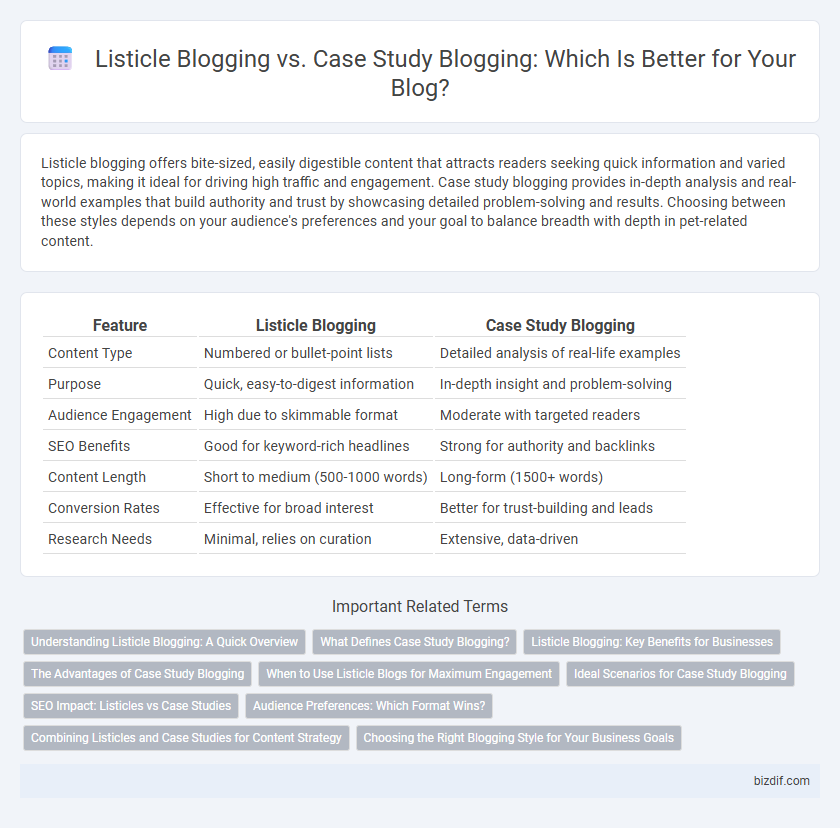Listicle blogging offers bite-sized, easily digestible content that attracts readers seeking quick information and varied topics, making it ideal for driving high traffic and engagement. Case study blogging provides in-depth analysis and real-world examples that build authority and trust by showcasing detailed problem-solving and results. Choosing between these styles depends on your audience's preferences and your goal to balance breadth with depth in pet-related content.
Table of Comparison
| Feature | Listicle Blogging | Case Study Blogging |
|---|---|---|
| Content Type | Numbered or bullet-point lists | Detailed analysis of real-life examples |
| Purpose | Quick, easy-to-digest information | In-depth insight and problem-solving |
| Audience Engagement | High due to skimmable format | Moderate with targeted readers |
| SEO Benefits | Good for keyword-rich headlines | Strong for authority and backlinks |
| Content Length | Short to medium (500-1000 words) | Long-form (1500+ words) |
| Conversion Rates | Effective for broad interest | Better for trust-building and leads |
| Research Needs | Minimal, relies on curation | Extensive, data-driven |
Understanding Listicle Blogging: A Quick Overview
Listicle blogging organizes content into numbered or bullet-point lists, making information easy to scan and digest for readers. This format enhances SEO by targeting specific keywords and providing structured, shareable content that attracts higher engagement. Popular in lifestyle, travel, and tech niches, listicles efficiently deliver bite-sized insights and actionable tips.
What Defines Case Study Blogging?
Case study blogging is defined by its focus on in-depth analysis of real-life examples, showcasing detailed problem-solving processes and measurable outcomes. It relies heavily on data-driven insights, chronological narratives, and expert commentary to illustrate how specific challenges were addressed effectively. This approach enhances credibility and engages readers seeking practical applications and proven results within a particular niche.
Listicle Blogging: Key Benefits for Businesses
Listicle blogging enhances user engagement by presenting information in easily digestible, numbered formats that boost readability and shareability. This format improves SEO performance through targeted keywords and structured content, increasing organic traffic and search engine ranking. Businesses benefit from listicle blogging by quickly showcasing expertise, driving higher conversion rates, and fostering audience retention.
The Advantages of Case Study Blogging
Case study blogging provides in-depth analysis and real-world examples that enhance credibility and trustworthiness with readers. It offers actionable insights backed by data, making content highly valuable for solving specific problems or demonstrating expertise. This approach drives higher engagement and conversion rates by showcasing practical success stories and measurable outcomes.
When to Use Listicle Blogs for Maximum Engagement
Listicle blogs work best when targeting readers seeking quick, easily digestible information, such as product comparisons, tips, or top trends, boosting engagement through clear structure and scannability. They perform well in industries like lifestyle, technology, and travel, where concise summaries and visual elements enhance user experience. Leveraging SEO with targeted keywords in listicle titles can increase organic traffic, making them ideal for attracting broad audiences and encouraging social sharing.
Ideal Scenarios for Case Study Blogging
Case study blogging excels in showcasing real-world applications and detailed analysis, making it ideal for businesses aiming to demonstrate tangible results and build credibility. This approach works best when targeting an audience that values in-depth understanding and practical examples over broad overviews. Industries such as marketing, healthcare, and technology benefit significantly from case study blogs by highlighting client success stories and data-driven outcomes.
SEO Impact: Listicles vs Case Studies
Listicle blogging often generates higher click-through rates due to its easily scannable format and frequent use of targeted keywords, which boost search engine rankings. Case study blogging enhances SEO by providing in-depth, authoritative content rich in long-tail keywords and user engagement metrics, leading to increased domain authority over time. Balancing listicles for immediate traffic and case studies for sustained SEO growth maximizes organic visibility and audience trust.
Audience Preferences: Which Format Wins?
Listicle blogging appeals to audiences seeking quick, easily digestible information with clear, numbered takeaways, while case study blogging attracts readers interested in deep analysis and real-world applications. Data shows that 65% of readers prefer listicles for casual browsing, whereas 35% favor case studies for detailed insights. Understanding these preferences helps bloggers tailor content to maximize engagement and meet audience expectations effectively.
Combining Listicles and Case Studies for Content Strategy
Combining listicles and case studies enhances content strategy by blending concise, easily digestible information with in-depth, evidence-based insights, catering to diverse audience preferences. Listicle blogging drives traffic through skimmable, shareable formats, while case study blogging builds credibility by showcasing real-world results and detailed analysis. Integrating both formats maximizes engagement, improves SEO performance, and establishes authority in niche topics.
Choosing the Right Blogging Style for Your Business Goals
Listicle blogging offers concise, easy-to-digest content perfect for driving traffic and boosting engagement with frequent posts, while case study blogging provides in-depth analysis and builds credibility by showcasing real-world results. Align your blogging style with business goals by opting for listicles to attract broad audiences and generate leads quickly, or case studies to demonstrate expertise and nurture trust among potential clients. Evaluate your target audience's preferences and industry standards to determine whether quick wins or detailed insights will better support your growth strategy.
Listicle Blogging vs Case Study Blogging Infographic

 bizdif.com
bizdif.com